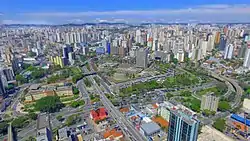Santo André, São Paulo
Santo André (Portuguese pronunciation: [sɐ̃twɐ̃ˈdɾɛ], Saint Andrew) is a Brazilian municipality located in the Metropolitan Region of São Paulo. It is part of a group of municipalities known as the ABC Region. According to the most recent census, the population is estimated at 721,368 (2020 est.) in an area of 175.8 km².[3] or about 43,441 Acres of landmass.
Santo André | |
|---|---|
 Aerial view of Santo André's downtown, highlighting City Hall Plaza at the photo centerpiece. | |
 Flag  Coat of arms | |
| Motto: Paulistarum terra mater (Latin) | |
 Location in São Paulo state | |
 Santo André Location in Brazil | |
| Coordinates: 23°39′26″S 46°32′00″W | |
| Country | Brazil |
| Region | Southeast |
| State | São Paulo |
| Named for | Andrew the Apostle |
| Government | |
| • Mayor | Paulo Serra (PSDB) |
| Area | |
| • Total | 175.8 km2 (67.9 sq mi) |
| Elevation | 700 m (2,300 ft) |
| Population (2020 [1]) | |
| • Total | 721,368 |
| • Density | 4,100/km2 (11,000/sq mi) |
| Demonym | Portuguese: Andreense |
| Time zone | UTC-03:00 (BRT) |
| • Summer (DST) | UTC-02:00 (BRST) |
| Postal code | 09000-000 |
| Area code | +55 11 |
| HDI | 0.815 – very high[2] |
| Website | www |
It is the 15th most developed Brazilian city,[4] and the eighth most developed city in the State of São Paulo, according to the UN.[5] The city is also known to be the fifth best city in the country to raise children on the grounds of public and private education and health care.[6]
History
The first settlement named Santo André in the region where the modern city stands was founded by João Ramalho in 1553, with the name of Santo André da Borda do Campo (English: Saint Andrew of the Field's Edge), however, this first village was short lived, as in 1560, the then governor-general of the State of Brazil, Mem de Sá, ordered the transfer of inhabitants to the proximities of the jesuit college of São Paulo, which was deemed to be in a more secure position.[7]
A town with the name of Santo André would only emerge again in the 1838, when the headquarters of the then municipality of São Bernardo was transfered to the proximities of the then-district of Santo André, near a train station founded in 1867 by means of the São Paulo Railway Company.[7] The town experienced rapid growth beginning in the 1930s.
Industries include chemical engineering, textiles, oil, metal products, metallurgy and printed matter. Despite being an industrial city, more than 60% of Santo André's total area are protected by environmental water laws, mainly in the district of Paranapiacaba.
In 1954, it became the seat of the Roman Catholic Diocese of Santo André.
In 2002 the city shot to national prominence with the assassination of serving mayor Celso Daniel, whose murder remains unsolved.
Districts
- Distrito Sede - Santo André
- Paranapiacaba
- Distrito de Utinga - Santo André
- Distrito de Capuava - Santo André
Demography
| Color/Race | Percentage |
|---|---|
| White | 65.8% |
| Mixed | 16.9% |
| Black | 15.4% |
| Asian | 1.2% |
| Amerindian | 0.1% |
Source: Census 2010
Sports
Football
- Football Team - Esporte Clube Santo André, the football (soccer) team of the city.
- City Stadium - Estádio Bruno José Daniel - Capacity: 15,157
Titles
- Brazilian National Cup Champion in 2004, beating Flamengo in final game at Maracana Stadium in front of more than 80,000 Flamengo fans.
- Paulista 2nd Division Champions in 1967, 1975, 1981 and 2008.
- Copa Estado de São Paulo, 2003
- Copa São Paulo Under-20, 2002
- Pelé scored his first professional goal ever at Santos Futebol Clube in Santo André Stadium
Volleyball
- Men's Volleyball Team - Pirelli Volleyball Club
- Men's World Club Champion in 1984. Later, the team had his name changed to Shopping ABC
- Santo André due to a new sponsorship contract signed with Shopping ABC, one of the biggest malls in the city.
Basketball
- Men's Basketball Team - Pinheiros Santo André - Plays Paulista League of Basketball
Boxing
- Hosts national Olympic team at Pedro Dell'Antonia Gymnasium facilities.
Twin towns – sister cities
Santo André is twinned with:[8]
 Ribeira Brava, São Nicolau Island, Cape Verde
Ribeira Brava, São Nicolau Island, Cape Verde Takasaki, Gunma, Japan
Takasaki, Gunma, Japan
Notable people
References
- IBGE 2020
- "Ranking decrescente do IDH-M dos municípios do Brasil" (PDF). Atlas do Desenvolvimento Humano. Programa das Nações Unidas para o Desenvolvimento (PNUD). 2010. Retrieved 31 July 2013.
- Instituto Brasileiro de Geografia e Estatística
- "O ranking definitivo das cidades mais desenvolvidas do país". EXAME. 8 July 2014. Retrieved 8 July 2014.
- "10 cidades mais desenvolvidas de cada estado, segundo a ONU". EXAME. 3 August 2014. Retrieved 3 August 2014.
- "As melhores e piores grandes cidades para criar seus filhos". EXAME. 2 March 2015. Retrieved 2 March 2015.
- "História de Santo André". Prefeitura Municipal de Santo André. Retrieved 2023-10-21.
- "Anuário de Santo André 2013" (PDF). santoandre.sp.gov.br (in Portuguese). Santo André. 2013. p. 88. Retrieved 2020-05-22.
External links
- Santo André City Hall (in Portuguese)